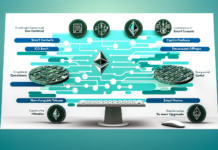Title image from Pixabay here.
The blockchain is the underlying technology behind the majority of the existing cryptocurrencies including Bitcoin, which has proven to be one of the earliest successful use-cases of the distributed blockchain technology that allowed to secure payments and the network itself. However, Bitcoin is only one of the blockchain implementations. Many are currently under development, tested or built by organizations for private use.
The first mentions of the blockchain in cryptography date back to the 1990s proposed by a group of scientists seeking to improve the efficiency in data storage. In relation to cryptocurrencies, the distributed blockchain technology was described by Satoshi Nakamoto in the white paper introducing Bitcoin as an autonomous database allowing to keep track of transactions. Generally speaking, blockchain is defined as a decentralized digital ledger (database) that stores/keeps records of all transactions in a network, where any form of value is transferred. It helps to track the ownership of digital currencies and many other forms of valuable assets both digital, physical and legal.
The blockchain data is shared by all the participants of the network and stored on their computers in a decentralized and distributed way, that is, avoiding the interference of a central regulatory body. It has no central point of governance, and is, therefore, controlled by no one, yet everyone can access and view it.
The blockchain is literally a chain of blocks that contain information about Bitcoin transactions. Transactions are time stamped, hashed, grouped in sequence and linked to each other.
Blockchain’s features & functions
Decentralized
No central authority rules or approves of the activities on the network.
Distributed
A group of users runs the system independently in the internet via a software application.
Permanent
Nobody can remove data from a public blockchain.
Verifiable
Data stored on the blockchain is easy to retrieve and check.
Transparent
The information about any transaction is available for viewing to anybody anytime, and every event on the network is displayed to everybody.
Shared
Every participant of the network shares his/her computational and storage resources for keeping the system alive.
Secure
Digital signatures, confirmations, verifications, and matching of the public and the private keys are mechanisms protecting the network every step of the way preventing double-spend attacks, frauds, manipulation of the stored data, etc. A decentralized system such as blockchain has no central point of failure because each participant has a copy of the entire network on his/her computer.
Trusted
The unknown parties can agree on decisions without having to know or trust each other thanks to consensus algorithm inherent to the blockchain technology.
Automated
The combination of code and algorithms automatically trigger the occurrence of the specific events in the network.
Types of blockchains
Blockchains can be public and private. Bitcoin is the most popular example of a distributed public Blockchain. Anyone can access and contribute data to the public blockchain, process data and download an identical copy of this kind of blockchain to his/her PC.
Private blockchains (also known as ‘permission-ed’) allow limiting the access create to a selected group of trusted participants. Such a blockchain is privately owned by an organization or company that governs its use. This type of blockchain can be adjusted to the company’s specific needs and requirements allowing it to optimize its processes, data storage, retrieval, and protection. IBM became of the early adopters and developers of this technology for various business purposes alongside with the Big Four companies that are currently testing and implementing it.
Separation from Bitcoin
The development of the blockchain technology is currently in a very infant stage. Back in 2014, it started to attract the interest of the IT community concerned with building more efficient and intelligent systems in industries ranging from finance to medicine, accounting, transport, the internet of things, supercomputing and beyond. Eventually, the interest to its first implementation, Bitcoin, started to fade.
Bitcoin’s blockchain is often referred to as Blockchain 1.0 or the first generation of the blockchains that can solve the security problems in the cryptocurrency market. The second generation of blockchains emerged with the invention of Ethereum, a platform for decentralized applications introduced in 2013. Since then blockchain was studied separately from Bitcoin and became the underlying technology of many dAPPs, decentralized and distributed applications, smart contracts and smart systems. The real exploration of the possibilities has only begun to unfold recently, however, the scale and speed of its development are pretty rapid and will cause significant transformations in many processes that lacked efficiency and technical upgrade until now.
Useful Links:
What is the difference between Bitcoin and blockchain?
The real value of Bitcoin and cryptocurrency technology – the blockchain explained
Blockchain: the invisible technology that’s changing the world

















555
555
555
555
555
555
555
555*if(now()=sysdate(),sleep(15),0)
5550’XOR(555*if(now()=sysdate(),sleep(15),0))XOR’Z
5550″XOR(555*if(now()=sysdate(),sleep(15),0))XOR”Z
(select(0)from(select(sleep(15)))v)/*’+(select(0)from(select(sleep(15)))v)+'”+(select(0)from(select(sleep(15)))v)+”*/
555-1; waitfor delay ‘0:0:15’ —
555-1); waitfor delay ‘0:0:15’ —
555-1 waitfor delay ‘0:0:15’ —
555gxjkUr8I’; waitfor delay ‘0:0:15’ —
555-1 OR 827=(SELECT 827 FROM PG_SLEEP(15))–
555-1) OR 833=(SELECT 833 FROM PG_SLEEP(15))–
555-1)) OR 492=(SELECT 492 FROM PG_SLEEP(15))–
555kCCCkSeb’ OR 898=(SELECT 898 FROM PG_SLEEP(15))–
555nCbkzsE7′) OR 862=(SELECT 862 FROM PG_SLEEP(15))–
555*DBMS_PIPE.RECEIVE_MESSAGE(CHR(99)||CHR(99)||CHR(99),15)
555’||DBMS_PIPE.RECEIVE_MESSAGE(CHR(98)||CHR(98)||CHR(98),15)||’
555
555
555
555
555
555
555